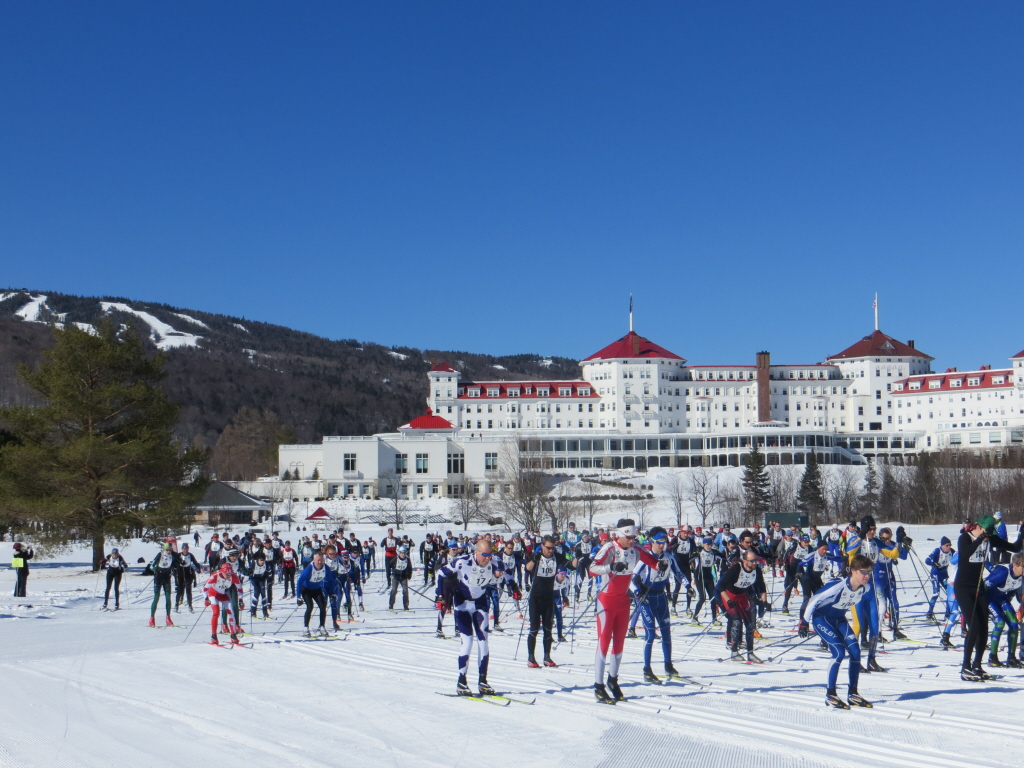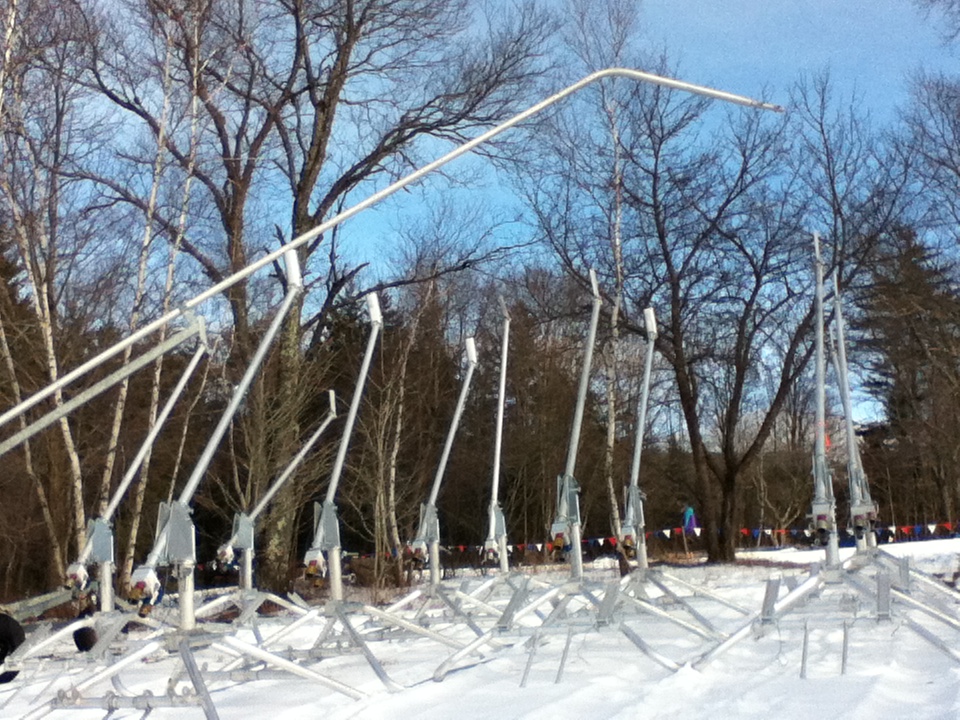
“I think if you’re a nordic skier in New England, you should definitely be alarmed.”
“That’s one of the main take-homes: skiing is not going to disappear completely, but it will generally be higher [in elevation].”
So says Cameron Wobus, a Bowdoin ski team alumnus and a researcher at Abt Associates, a global research firm. Wobus and colleagues based in Boulder, Colo., and Washington, D.C., recently published a study in Global Environmental Change assessing the impact of projected climate change on the ski industry. (The article is available free of charge here.)
Their results: by 2090, many cross-country ski areas across the U.S. are likely to see 50-100 percent reductions in season length. That could translate to more than a million fewer visits by skiers, and millions of dollars of losses in trail-pass revenue.
A lucky few ski areas could see only minor impacts, but a lot of that depends on greenhouse-gas emissions scenarios – basically, what the world does to curb the release of carbon dioxide and other greenhouse gases between now and then.
“I think a main finding is that elevation is your friend, which isn’t surprising,” Wobus said in a phone interview from Boulder last week. “If you’re a ski area in the Rockies and your base elevation is 10,000 feet, you’re obviously in better shape than if you’re a ski area in central Vermont and your base elevation is 500 feet.”
The Nerdy Part of Prediction
A previous report by Protect Our Winters and the Natural Resources Defense Council took a more detailed look at the economics of the winter sports industry under projected climate change.

What Wobus and his colleagues wanted to do rather than to get bogged down in predicting how interest and tourism for winter sports would change in a warmer world, was to make the best possible predictions of how snowpack and season length would be affected at ski areas.
“We wanted to do was a more detailed analysis of the physical snowpack modeling,” Wobus explained.
To get to their conclusions, the research team modeled snowpack at 247 alpine and nordic ski areas by combining historical datasets, climate change models, and greenhouse gas emissions scenarios. As a starting point, they used North American Land Data Assimilation System meteorological forcing data, which has been recorded at a fine scale since 1979.
They then put this meteorological data into the Utah Energy Balance model to derive snowpack at ski areas, based on what comes out of the sky and landscape factors that would determine how long snow stays on the ground.
When the researchers compared this derived snowpack estimate to actual measurements of winter season length collected for the Snow Data Assimilation System – a framework that combines satellite data, airborne measurements, and on-the-ground observations – the match was solid.
“We did a reasonably good job,” Wobus said. “Not surprisingly, it’s a little bit messy … but on a region-by-region basis, the only thing we need to get out of the physical model is the season length. So with the exception of the Pacific Southwest, we are generally capturing trends in season length from region to region.”
With that information about winter season length in different parts of the U.S. in hand, the researchers applied different climate change models to predict the magnitude of reduction in season length.
“We applied a simple delta from what all the climate models were telling us, to say, okay, we aren’t going to rely on the climate models to tell us what the weather is doing,” Wobus said. “We’re going to use a 30-year historical time series to look at natural month-to-month and year-to-year variation in weather. But then we’re going to superimpose on that weather, a climate change signal that is a change in monthly average temperature and monthly average precipitation, coming out of different climate models and different emissions scenarios.”
The climate models used, known as General Circulation Models, or GCMs, are mathematical representations of the physical processes happening on and around the earth.
“[GCMs], representing physical processes in the atmosphere, ocean, cryosphere and land surface, are the most advanced tools currently available for simulating the response of the global climate system to increasing greenhouse gas concentrations,” the Intergovernmental Panel on Climate Change writes on its website. “GCMs depict the climate using a three-dimensional grid over the globe, typically having a horizontal resolution of between 250 and 600 km, 10 to 20 vertical layers in the atmosphere and sometimes as many as 30 layers in the oceans.”
There are many different GCMs – and while they are pretty good at predicting temperature, their predictions about precipitation vary widely.
“The precipitation predictions tend to be all over the map,” Wobus said. “We tried to beat it down to the extent that we could by using as many different climate models as we could, given the constraints of our budget. And by modeling as many years as we would, again, given the constraints of how much time we have to do the modeling.”
In the end, that meant using five different GCMs. And additionally, the team put all of those models through two different greenhouse gas emissions scenarios.

The Findings
Especially under the high-emissions scenario, a lot of the differences between predictions made from the different GCMs disappeared by 2090.
The authors demonstrated this in a graph of predicted season length for the Bretton Woods cross-country ski area in northern New Hampshire. They showed the predictions for all five GCMs under both emissions scenarios, compared to the baseline season length at present (68 days, with a range of up to 150 days).
By 2050 under a lower emissions scenario, mean season length dropped precipitously to roughly 12-33 days, but the range of possible season lengths is quite wide for some of the GCMs.
“All these different GCMs have different parameterizations of precipitation, and so they are all going to do slightly different things,” Wobus said.
By 2090 under a high-emissions scenario, though, the model predictions all converge between two and 13 days, and the current average season length is not even in the range of possible predictions for any of the models.
“By 2090, it’s pretty clear that your distribution of season lengths is very different from baseline to future,” Wobus explained. “That’s kind of regardless of which [emissions scenario] you pick, but RCP 8.5 [the higher emissions scenario] is worse.
“That’s one of the main takeaways from the paper,” he continued. “Climate change isn’t good for skiing in the future, but a greenhouse-gas mitigation scenario looks better than a no-mitigation scenario, pretty much across the board.”
Why is that? Despite the variability in the precipitation predicted by the models, temperature increases would be so great by 2090 that precipitation largely wouldn’t matter.
“You’re looking at close to 10 degrees Fahrenheit of warming,” Wobus said, discussing predictions for the Midwest. “It doesn’t necessarily protect you to be way up north or to be really frigid now. There’s obviously a latitudinal dependence on where things are worse, along with elevation. So maybe if you’re up in northern Michigan with [the higher-emissions scenario] you might still have half your ski season, but it’s certainly going to be shorter than you’re used to.”

Part of this prediction arises from the fact that the team assumed that cross-country ski areas don’t use snowmaking. Wobus said that he knows some nordic areas are investing heavily into snowmaking (or snow storage), but in general, not enough currently use it to build into their projects as they did for alpine ski areas.
But even if ski areas were to rely on snowmaking, they might be in trouble. For instance, under a high low emissions scenario, just 23 percent of alpine ski areas would have accumulated enough hours of snowmaking in 2090 to open by Dec. 15. As most of the cross-country ski areas are restricted to lower-elevation areas at the bottom of mountains, they would not be in better shape.
Without snowmaking, a high-emissions scenario would lead to roughly 87,000 fewer visits to cross-country ski areas by 2050 and 1.1 million fewer visits in 2090 – equivalent, by that point, to $10.2 million less in trail passes sold.
Are We Listening?
The idea for this piece of research came while spitballing.
“We’ve been doing work for ten years around impact of climate change on various sectors of the economy,” Wobus said. “I’ve published papers on the impacts of ocean acidification and ocean warming on coral reefs and linking that to a recreational use model. I did one on inland flooding and monetary damages from flooding. We’ve done all these different sectoral analyses for different economic impacts of climate change.”
Living in Boulder and being skiers, the team thought – why not look at that?
“We were basically pitching ideas, and we were like, skiing is a pretty important industry in certain parts of the country and it probably has a serious economic impact … so we did it,” Wobus laughed.
But the findings have made a splash.
“People seem to have been noticing,” Wobus said. “I actually credit Global Environmental Change for having a Twitter feed, of all things. Protect Our Winters picked it up, and Powder Magazine picked it up. … Most times people don’t pay any attention to my research. So it’s kind of cool to have something that’s a little more out there.”
Chelsea Little
Chelsea Little is FasterSkier's Editor-At-Large. A former racer at Ford Sayre, Dartmouth College and the Craftsbury Green Racing Project, she is a PhD candidate in aquatic ecology in the @Altermatt_lab at Eawag, the Swiss Federal Institute of Aquatic Science and Technology in Zurich, Switzerland. You can follow her on twitter @ChelskiLittle.



